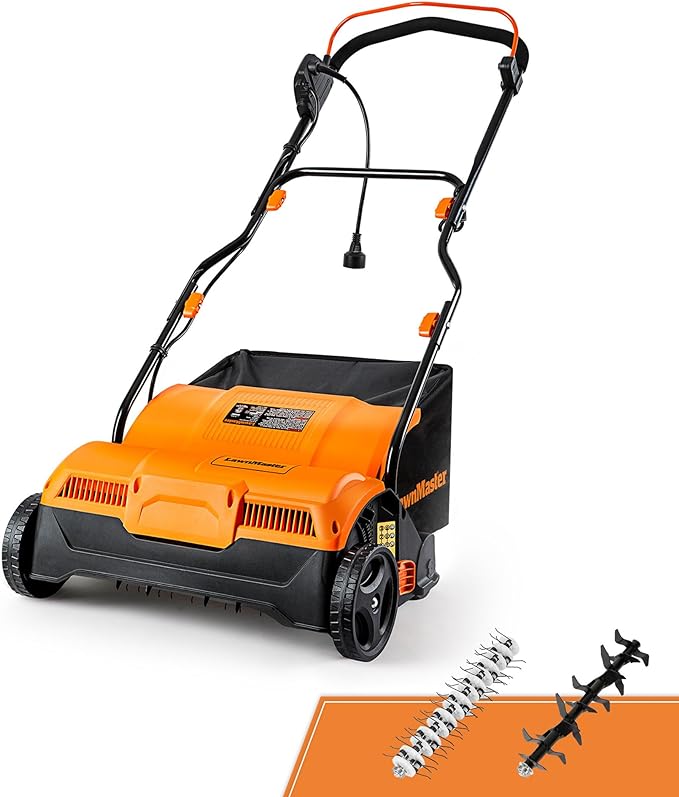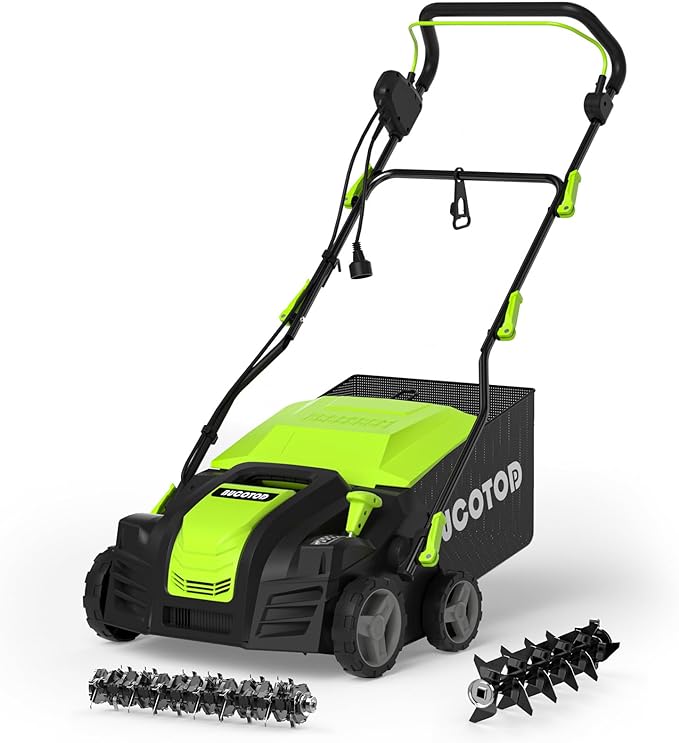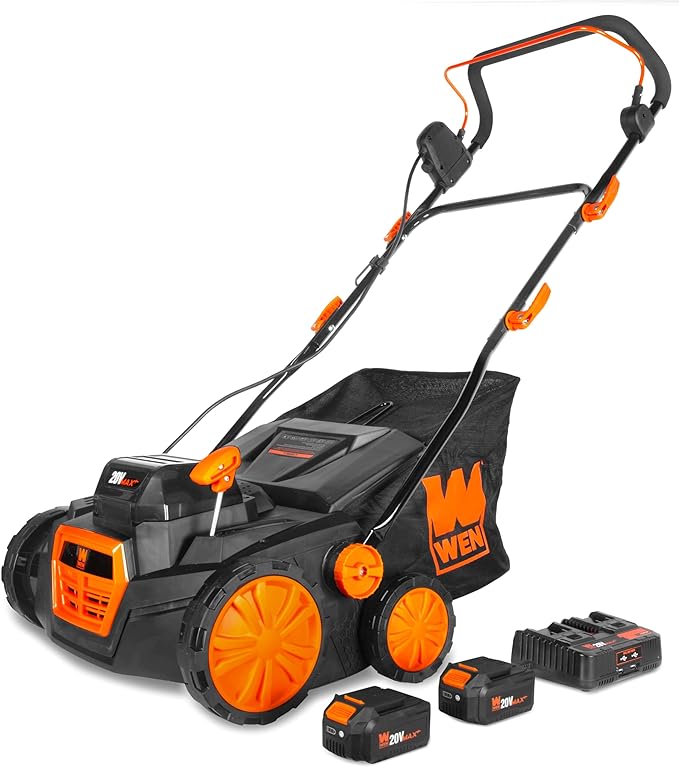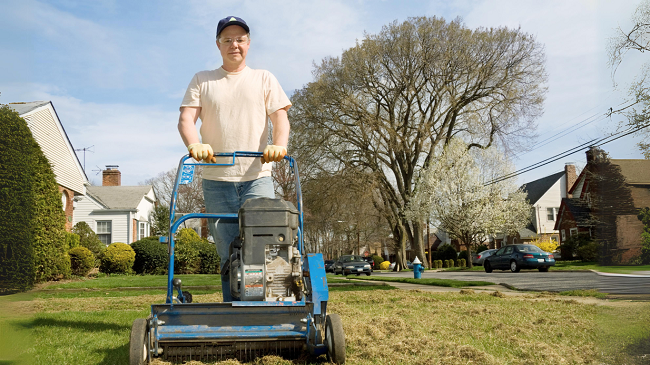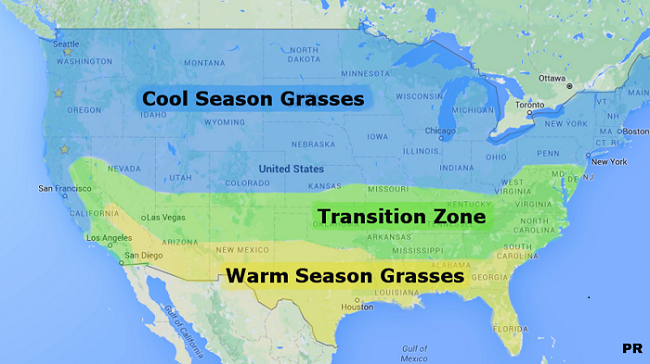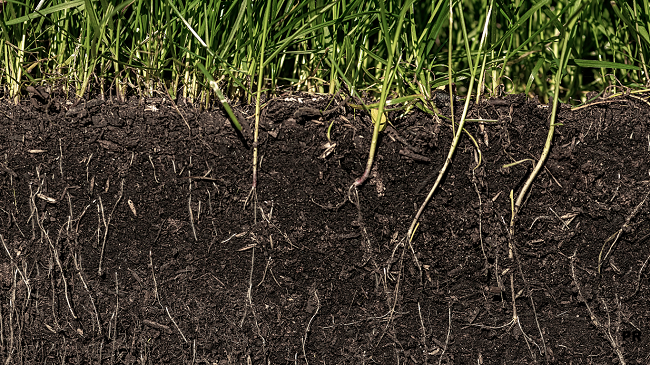The 3 Best Dethatcher to Buy Online
If you want your lawn to look green and healthy, it takes more than just watering and mowing. There’s a special lawn care trick that many people forget about—dethatching. But what is dethatching, and why is it important? Let’s explore!
Table of Contents
Here are the top 3 dethatchers that redefine lawn care and convenience:
1. LawnMaster GVB1316 Electric 16” 13 Amp
Ready to give your lawn a fresh look? The LawnMaster GVB1316 electric dethatcher might be just what you need. Let’s check out its features, what people like (and don’t like), and see if it’s right for your yard.
Features:
- Electric Powered: No gas or oil! Just plug it in and start dethatching.
- 16-Inch Working Width: Covers a good area of your lawn with each pass.
- 13-Amp Motor: Strong enough to handle most thatch issues.
- Scarifier Function: Besides dethatching, it also helps loosen compacted soil, letting water and air reach the roots better.
- Adjustable Depth: You can change the dethatching depth to match your lawn’s needs.
- 12-Gallon Collection Bag: Collects the dislodged thatch, so you don’t have to rake it up.
Pros:
- User-Friendly: Simply plug it in, and you’re all set! Much easier than using manual tools.
- Good Power: The motor is strong enough for most lawns.
- Saves Time: The collection bag helps you clean up the thatch without extra work.
- Multi-Use Tool: It can dethatch and loosen the soil, solving more than one lawn problem.
Cons:
- Limited Width: With a 16-inch width, it might take longer to cover large lawns.
- Not for Thick Thatch: Some people say it’s not strong enough for very thick layers of thatch.
- Small Bag: The 12-gallon bag might need to be emptied often if you have a big yard.
What Customers Say:
- Simple and Efficient: Users appreciate its ease of use and find it effective for light to moderate thatch removal.
- Collection Bag Issues: Some people think the collection bag is too small or not very sturdy.
- Warranty Concerns: A few customers mentioned problems with getting warranty service.
2. 2-IN-1 16-Inch Dethatcher
This electric lawn tool does two important jobs: dethatching and scarifying. Dethatching gets rid of dead grass that can suffocate your lawn, while scarifying helps loosen up hard soil so air, water, and nutrients can reach the roots.
Features:
- Powerful 15-Amp Motor: Strong enough to handle tough jobs.
- 16-Inch Working Width: Covers a lot of lawn in one go.
- 2-in-1 Function: It has blades for dethatching and scarifying, and you can easily switch between them.
- 5 Depth Settings: Adjust the depth to match your lawn’s needs.
- Large 14.5-Gallon Collection Bag: Holds a lot of thatch, so you don’t have to empty it as often.
- Adjustable Handle: Makes it comfortable to use, no matter how tall you are.
Pros:
- Works Well: Customers notice that their lawns look healthier and thicker after using this tool.
- Easy to Use: Most people find it simple to set up and adjust.
- Saves Time: The wide width and large bag mean you can cover more ground quickly.
- Versatile: It handles two lawn tasks in one go, saving you effort.
Cons:
- Corded: You’ll need an extension cord, which might limit how far you can reach.
- Heavy: Some users find it a bit hard to move around, especially on larger lawns.
- Loud: The motor can be noisy.
What Customers Say:
Many people are happy with how well this dethatcher/scarifier works, saying their lawns look better after using it. Some mention that it’s a little heavy and loud, but the results are worth it.
3. WEN 20V Max Cordless 15-Inch 2-in-1 Brushless Electric Dethatcher
Is your lawn struggling with thatch (dead grass) buildup? The WEN 20V Max Cordless Dethatcher and Scarifier (model 20716) could be the tool you need! It helps remove dead grass and loosen hard soil to keep your lawn healthy. Here’s a look at what it offers:
Features:
- Battery-Powered: No need for an extension cord. This scarifier runs on two rechargeable 4.0 Ah batteries.
- 2-in-1 Function: This tool removes dead grass and loosens compacted soil, making it easier for air and water to reach your lawn’s roots.
- 15-Inch Working Width: It covers a lot of ground with each pass, saving you time.
- Brushless Motor: The motor is powerful and consistent for better dethatching.
- Adjustable Depth: You can change how deep it digs to avoid damaging your grass.
- Collection Bag: Picks up the dead grass as you go, so no raking is needed afterward.
- Dual-Port Charger: Quickly charges both batteries at the same time, so you can get back to work faster.
Pros:
- Lightweight and Easy to Use: Most people find it easy to push and handle.
- Cord-Free: No need to worry about cords getting tangled or not reaching far enough.
- Two Batteries: You can work longer by switching between batteries while one charges.
- Quiet: It’s quieter than gas-powered scarifiers, so it won’t make as much noise.
Cons:
- Battery Life: The batteries may need recharging if you have a large lawn.
- Not for Thick Thatch: If your lawn has a lot of thatch buildup, you might need a stronger dethatcher.
- Small Collection Bag: The bag may fill up fast if you have a bigger yard.
What Customers Say:
People generally love how easy it is to use and how well it removes thatch. Some wish the collection bag was larger or that it had a bit more power for very thick thatch, but most agree it works great for regular lawns.
What is Thatch?
Thatch is a layer of dead grass, roots, and other plant material that builds up between the soil and the green part of your lawn. A little thatch is normal and can be helpful, but too much can block water, nutrients, and air from getting to the soil.
How Thatch Hurts Your Lawn
Excessive thatch can lead to issues with your lawn. It blocks important nutrients from reaching the soil, making the grass weak and thin. It can also make your lawn more likely to get pests and diseases.
Types of Dethatchers
Manual Dethatchers
These are basic tools you drag across your lawn to break up the thatch. They are best for small lawns or if you have only a little thatch to remove.
Electric Dethatchers
Powered by electricity, these are good for medium-sized lawns. They’re easier to use than manual scarifier and don’t need as much physical effort.
Gas-Powered Dethatchers
Powered by gas, these machines offer the highest level of performance. They work well for larger lawns but can be noisy and need regular maintenance.
Comparison of Dethatcher Types
- Manual Dethatchers: Cheap and good for the environment, but you have to work hard to use them.
- Electric Dethatchers: Easier to use, but you need a power source.
- Gas-Powered Dethatchers: The strongest option, but they are loud and need more care.
How to Choose the Right Dethatcher
Size of Your Lawn
If you have a big lawn, a gas-powered dethatcher might be best. For smaller lawns, a manual or electric dethatcher will work.
How Often You’ll Use It
If you need to dethatch a lot, it’s worth spending more on a durable scarifier.
Your Budget
Manual dethatchers are the cheapest. Electric and gas dethatchers cost more, so pick the one that fits your needs and budget.
How to Use a Dethatcher
Getting Your Lawn Ready
- Cut your lawn to half of its normal height.
- Water your lawn lightly the day before. This allows the scarifier to operate more effectively.
Steps for Dethatching
- Set the Blades: Adjust the blades to the right height.
- Work in Rows: Go in straight lines and overlap each row a little bit.
- Clean Up: Rake up the dead grass (thatch) and throw it away.
Taking Care of Your Lawn After Dethatching
- Water your lawn right after.
- Consider adding a little fertilizer to help your grass grow back strong.
Best Time to Dethatch Your Lawn
Ideal Season:
Dethatch in early spring or early fall. This helps your grass recover in the best possible way.
Weather Conditions:
Don’t dethatch when it’s super hot or during a drought. Mild, moist weather is best for recovery.
How to Maintain Your Dethatcher
- Clean It: Remove any grass and dirt after each use.
- Blade Care: Keep the blades sharp, or replace them if they wear out.
- Storage: Store the scarifier in a dry place to avoid rust.
Common Dethatching Mistakes to Avoid
- Over-Dethatching: Don’t remove too much thatch at once, or you could damage your lawn.
- Bad Timing: Dethatching during the wrong season can stress the grass. Stick to spring or fall.
- Skipping Aftercare: Failing to water or fertilize your lawn after dethatching can slow down recovery.
Other Lawn Care Tips
- Aeration: Aerating your lawn (poking small holes in the soil) helps roots grow better and works well with dethatching.
- Fertilizing: Adding fertilizer gives your lawn the nutrients it needs to stay healthy.
- Regular Mowing: Mowing your lawn regularly can help prevent too much thatch from building up.
Why Dethatching is Good for the Environment
- Healthier Soil: Dethatching improves the soil, helping your grass grow better.
- Fewer Chemicals: A healthy lawn needs fewer chemicals, which is better for the environment.
New Technology in Dethatching
- Latest Innovations: New scarifier are easier to use and have better blade designs.
- Future Tools: Expect smarter and more eco-friendly dethatching tools to come out in the future, making lawn care even easier.
Frequently Asked Questions (FAQs)
What’s the difference between dethatching and aerating?
Dethatching removes the layer of dead grass (thatch) from the surface. Aerating creates small holes in the soil to let air, water, and nutrients reach the roots.
Can I dethatch my lawn by myself?
Yes! With the right tools and a little knowledge, you can dethatch your lawn on your own and save some money.
How often should I dethatch my lawn?
Usually, you should dethatch every 1 to 3 years. It depends on how much thatch builds up in your lawn.
Is dethatching good for all types of grass?
Most grass types benefit from dethatching, but some, especially certain warm-season grasses, may need it at a specific time.
What should I do with the thatch after dethatching?
If not, be sure to follow local yard waste regulations for proper disposal.
Conclusion
Dethatching plays a key role in maintaining a healthy and green lawn. By learning the process, choosing the right tools, and taking care of your lawn afterward, you can enjoy a beautiful lawn that everyone will admire. Start dethatching today, and your lawn will thank you tomorrow!

